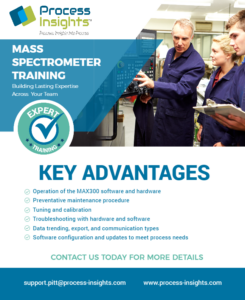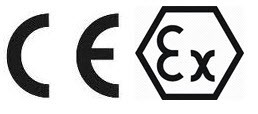Quadrupole Mass Spectrometers
Quadrupole Mass Spectrometry Technology
Our real-time EXTREL™ quadrupole mass spectrometers use a type of mass spectrometry technique that is used to measure the masses and relative abundances of ions in a gas or vapor sample. The technique is based on the principle that ions of different mass-to-charge (m/z) ratios will follow different paths through a set of quadrupole rods when subjected to an electric field.
With our quadrupole mass spectrometry, the sample is introduced into a vacuum chamber and ionized using an ion source. The ions are then accelerated into a quadrupole mass filter, which consists of four parallel rods arranged in a square pattern. The rods are charged with a radio frequency voltage that creates a time-varying electric field.
As the ions enter the quadrupole mass filter, they are subjected to the electric field and are separated based on their m/z ratios. Ions with a particular m/z ratio will oscillate in a stable trajectory through the quadrupole rods and pass through the exit aperture, while ions with other m/z ratios will be unstable and will collide with the rods and be eliminated from the sample. The ions passing through the quadrupole rods are detected using an electron multiplier detector. The detector generates a signal proportional to the number of ions that strike its surface, and this signal is then amplified and processed to provide a mass spectrum of the sample.
Our quadrupole mass spectrometry has a wide range of applications in fields such as chemistry, physics, environmental science, and engineering. It is commonly used for the analysis of gases and vapors, including the identification of unknown compounds, quantification of trace impurities, and monitoring of reaction products in real-time. The technique is also useful for the analysis of biological molecules such as proteins and peptides, as well as for the analysis of isotopes and stable isotopic ratios.
PROCESS MASS SPECTROMETRY (MAX300)IN-PERSON TRAINING
PLEASE CONTACT US FOR PRICING at support.pitt@process-insights.com.
2024 Training Schedule
|
May 6 – 9 |
PI Americas Headquarters, Houston TX |
|
June 3 – 6 |
PI Pittsburgh, PA |
|
August 5 – 8 |
PI Americas Headquarters, Houston TX |
|
September 16 – 19 |
PI Pittsburgh, PA |
|
October 14 – 17 |
PI Americas Headquarters, Houston TX |
When you are ready to register for a training session, please complete the PI Mass Spec Training – Order Form 2024 for each student and then return it by fax or email.
Fax +1 (412) 963-6578 | Email orders.pitt@process-insights.com

Need help? Complete our Mass Spectrometer
Application Questionnaire.
Application Questionnaire.
QUADRUPOLE MASS SPECTROMETERS
-

BENEFITS
The EXTREL quadrupole mass spectrometer offers several benefits for various applications. Here are some of its key advantages:
- High Sensitivity: provides exceptional sensitivity, allowing for the detection and analysis of trace levels of gases and volatile compounds. This sensitivity is particularly useful in applications where low concentrations of analytes need to be measured accurately.
- Wide Dynamic Range: The instrument offers a wide dynamic range, enabling the measurement of both high and low abundance species within a single analysis. This versatility is valuable when dealing with complex sample matrices or when the concentration levels of the target analytes vary significantly.
- Rapid Data Acquisition: Offers fast scan rates and rapid data acquisition, allowing for real-time analysis and monitoring. This capability is beneficial in time-critical applications or when there is a need for quick feedback and decision-making.
- High Resolution: The mass spectrometer provides high resolution, allowing for the differentiation of closely related compounds or isotopes. This feature is particularly useful in applications such as metabolomics, proteomics, and environmental analysis, where the identification and characterization of specific compounds are crucial.
- Versatility and Flexibility: Can be adapted to various analytical techniques and sample types. It can be equipped with different ionization sources and interfaces, enabling analysis in multiple modes. This versatility makes it suitable for a wide range of applications across different scientific disciplines.
- Robust and Reliable: Known for their robust construction and reliable performance. They are designed to withstand demanding laboratory environments and offer long-term stability and durability, ensuring consistent and accurate results over time.
- Advanced Software and Data Analysis: Supported by sophisticated software packages that facilitate instrument control, data acquisition, and analysis. These software tools provide intuitive user interfaces, powerful data processing capabilities, and options for data visualization, making it easier to interpret and extract meaningful information from the acquired mass spectrometry data.
-

APPLICATIONS
- Benzene Fenceline
- Biofuel Analysis
- Hydrogen Isotope & Helium Deuterium Analysis
- Gas Purity Analysis
- Plasma Analysis
- Fermentation Control
- Pyrolysis Analysis
- Ethylene
- Ethylene Oxide
- Natural Gas
- Iron, Steel & Metals
- Basic Oxygen Process (BOP)
- Blast Furnace Analysis
- Gas Mixing Stations
- Heat Treating
- Metal Coating Process
- Pharmaceutical Analysis
- Proteomics and Metabolomics
- Food and Beverage Analysis
- Forensic Analysis
- Material Science
- Atmospheric Chemistry
- Thermogravimetric analysis (TGA)
-

INDUSTRIES
Here are some examples of industries that use our EXTREL quadrupole mass spectrometers :
- Petrochemical industry: Used in the petrochemical industry to monitor and analyze the composition of gases in refinery processes, including gas processing, catalytic cracking, and hydrogen production.
- Semiconductor industry: Used in the semiconductor industry to monitor the gas composition during the production of semiconductor materials and devices, such as integrated circuits and computer chips.
- Environmental monitoring: Used in environmental monitoring to analyze air and water quality, and to detect and quantify pollutants and greenhouse gases in the atmosphere.
- Pharmaceutical industry: Used in the pharmaceutical industry to analyze the purity and composition of gases used in drug production, as well as to monitor the quality of the air in sterile manufacturing environments.
- Materials science: Used in materials science to analyze the composition of gases used in the production of new materials, such as ceramics and polymers.
- Food and beverage industry: Used in the food and beverage industry to analyze the composition of gases used in the production and packaging of food products, as well as to monitor the quality of the air in food storage and processing facilities.























